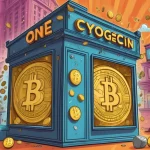XRP Hits $2.90 on ETF Hype as Remittix Raises $26.8M in Presale Shake-Up

XRP Price Surge to $2.90: ETF Rumors and Remittix $26.8M Presale Disrupt Crypto Payments
XRP is back in the spotlight with a price climb to $2.90 fueled by ETF speculation, while a newcomer, Remittix, has stunned the market by raising over $26.8 million in its presale. Let’s break down what’s driving XRP’s momentum, whether Remittix is a genuine contender or just another flash in the pan, and why the payments space remains a critical battleground for blockchain disruption.
- XRP Momentum: Price at $2.90 with ETF hopes and undervaluation signals.
- Remittix Rise: $26.8M presale positions it as a potential “Ripple 2.0.”
- Payments Focus: Both projects aim to overhaul slow, costly global transfers.
XRP’s ETF Hype: Boom or Bust?
XRP, the token developed by Ripple Labs, has long been a heavyweight in the realm of cross-border payments—think sending money overseas without the headache of traditional banks that charge hefty fees and take days to process. Currently sitting at $2.90 after bouncing back from a key support level of $2.50, XRP is showing signs of life that have traders buzzing. For the uninitiated, support levels are price points where a token often stops dropping due to renewed buying interest. Analysts are eyeing short-term targets at $2.98, $3.14, and $3.30, with some optimists predicting a breakout to $3.66 and even $5 in the longer term as discussed in recent XRP ETF updates and price predictions. Compared to Bitcoin’s steady grind or Ethereum’s smart contract dominance over the past month, XRP’s volatility feels like a wilder ride, but one with potential.
A big chunk of this excitement ties to speculation around exchange-traded funds (ETFs). Picture an ETF as a way for traditional investors to bet on XRP’s price without setting up a crypto wallet—essentially, it’s like buying stock in a company, but for a cryptocurrency. After Bitcoin ETFs got the green light in early 2024, the market is salivating for altcoins like XRP to follow suit. If approved, an XRP ETF could unleash a flood of institutional money, driving prices higher. On-chain metrics add fuel to the fire: the Network Value to Transactions (NVT) ratio, which compares a blockchain’s market cap to its transaction volume, suggests XRP might be undervalued. Think of it as a crypto version of a stock’s price-to-earnings ratio—a low NVT means the network is buzzing with activity relative to its price, often hinting at room to grow.
But let’s not get carried away. Risks loom large, and they could crash the party faster than a DeFi rug pull. If XRP dips below its $2.70 support, we could see a sharp sell-off. More critically, Ripple’s legal battle with the U.S. Securities and Exchange Commission (SEC) remains a dark cloud. The core issue—whether XRP is a security or not—has dragged on for years, with partial clarity but no final resolution as of late 2024. A single unfavorable ruling could send investors running. The SEC looms over XRP like a judgmental parent at a crypto rave, ready to shut things down. While the ETF hype is real, it’s a gamble hinging on regulatory outcomes and market sentiment.
Remittix: The New Kid on the Payments Block
While XRP holds court in the payments arena, a fresh face, Remittix, is challenging the status quo with a similar mission. This blockchain-based project has raised a jaw-dropping $26.8 million in its presale, selling over 673 million tokens at $0.1130 each. That’s the kind of haul that turns heads even among jaded crypto OGs. Focused on fast, secure, and low-cost cross-border money transfers, Remittix is pitching itself as a “Ripple 2.0.” Imagine sending $1,000 to a relative abroad and losing $50 to bank fees—that’s the pain point both XRP and Remittix are targeting, promising to slash costs and speed things up using blockchain tech.
Remittix isn’t just banking on hype. It’s ranked #1 for pre-launch tokens on CertiK, a respected blockchain security platform, lending a layer of trust in a space rife with scams. Beta testing for its wallet is already underway with select community members, and a referral program offers 15% back in USDT for bringing in new buyers—a classic crypto marketing tactic, but effective. Major exchange listings add credibility: BitMart signed on after Remittix hit a $20 million milestone, and LBank is next up. Landing on centralized exchanges like these boosts liquidity and visibility, a crucial step for any newcomer.
Still, let’s pump the brakes. Calling itself Ripple 2.0? That’s a bold claim for a project barely out of the cradle. What’s under the hood? Remittix touts faster transaction speeds than RippleNet, but without a widely available whitepaper or vetted dev team in the public eye, it’s tough to verify. The $26.8 million raise is impressive, but it’s pocket change compared to Ripple’s decade-long war chest. We’ve seen this movie before—think back to the 2017-2018 ICO mania when presales hyped projects to the moon, only to leave bagholders in the dust. While the numbers and partnerships look promising, Remittix’s lack of proven utility screams caution. If it nails even half its roadmap, it could shake things up—but that’s a big if.
Payments Revolution: Why It Matters for Crypto
Zooming out, both XRP and Remittix tap into a shared vision that’s at the heart of why many of us champion blockchain: dismantling outdated financial systems. Sending money across borders is still a nightmare—slow, expensive, and crawling with middlemen. Blockchain offers a way to slice through that mess, aligning with our push for decentralization, freedom, and privacy. XRP has been a pioneer here, despite its regulatory baggage, while Remittix could carve a niche if it dodges similar pitfalls. Even competitors like Stellar Lumens or newer protocols are in this race, each vying to solve the same global transfer woes.
As Bitcoin maximalists, we at Let’s Talk, Bitcoin see BTC as the ultimate digital gold—a store of value, not a payment tool. Payments aren’t Bitcoin’s forte, and that’s fine. Altcoins like XRP, and potentially Remittix, fill gaps BTC doesn’t aim to address. But let’s keep it real: XRP’s ETF dreams could crumble with one court decision, and Remittix’s meteoric rise carries the whiff of ICO-era madness. We’re all for effective accelerationism—turbocharging financial inclusion through tech—but not at the cost of ignoring red flags. Scammers and vaporware have no place in this revolution, and we’ll call out the nonsense when we see it.
Stepping back, XRP remains a titan with serious upside if the stars align on the institutional front. Remittix, on the other hand, is a wild card—thrilling for those betting on underdogs, but a gamble nonetheless. Whether XRP secures its ETF crown or Remittix flops as another presale mirage, one thing is clear: the fight to decentralize payments is heating up. This space is about disrupting the status quo, and we’re here to track every twist, turn, and potential faceplant along the way.
Key Takeaways and Questions
- What’s driving XRP’s climb to $2.90?
ETF rumors, historical Q4 rally trends, institutional interest, and on-chain metrics like the NVT ratio suggest undervaluation, with price targets stretching to $5. - What risks could tank XRP’s momentum?
A drop below the $2.70 support level or negative updates in Ripple’s SEC lawsuit could spark a brutal sell-off. - Why is Remittix stealing headlines with a $26.8M presale?
Its massive fundraising, top CertiK ranking, and mission to rival Ripple in blockchain payments—backed by BitMart and upcoming LBank listings—have ignited excitement. - Is Remittix a serious player or just hype?
While the numbers and partnerships impress, its unproven tech and lack of a long-term track record cast doubt compared to XRP’s established, if controversial, footprint. - Could an XRP ETF change the game?
Absolutely, as institutional inflows might spike prices, but regulatory hurdles and broader market sentiment remain unpredictable wild cards. - How do XRP and Remittix fit into the broader crypto payments race?
Both target inefficient global transfers—a key frontier for blockchain adoption—while Bitcoin sticks to its role as digital gold, not a day-to-day payment solution.



